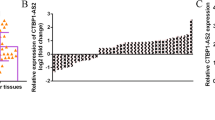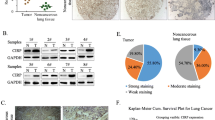Abstract
The multifunctional RNA-binding protein CUGBP1 regulates multiple aspects of nuclear and cytoplasmic messenger RNA (mRNA) processing, including splicing, stabilization, and translation of mRNAs. Previous studies have shown that CUGBP1 is overexpressed in non-small-cell lung cancer (NSCLC) tissues, but the pathological functions of CUGBP1 in tumorigenesis and development are unknown. Here, we provide the first evidence demonstrating the clinicopathological significance of CUGBP1 in NSCLC. Using immunohistochemistry, the levels of CUGBP1 expression in NSCLC tissues and adjacent non-cancerous tissues were examined and determined to be associated with differentiation. Short hairpin RNA-induced downregulation of CUGBP1 promoted apoptosis and decreased proliferation in the A549 NSCLC cell line. Moreover, Western blot analysis indicated that the depletion of CUGBP1 increased the protein levels of cyclin D1, BAD, BAX, Jun D, and E-cadherin, while the cyclin B1 level decreased. Knockdown of CUGBP1 decreased β-catenin and vimentin levels and increased E-cadherin expression, suggesting that CUGBP1 may contribute significantly to epithelial to mesenchymal transition (EMT) progression. These results demonstrate the importance of CUGBP1 in the biological and pathological functions of NSCLC and indicate its potential as a therapeutic target for NSCLC.









Similar content being viewed by others
References
Hecht SS. Tobacco smoke carcinogens and lung cancer. J Natl Cancer Inst. 1999;91:1194–210.
Jemal A, Siegel R, Ward E, Hao Y, Xu J, et al. Cancer statistics. CA Cancer J Clin. 2008;58:71–96.
Siegel R, Naishadham D, Jemal A. Cancer statistics, 2012. CA Cancer J Clin. 2012;62:10–29.
Kang S, Koh ES, Vinod SK, Jalaludin B. Cost analysis of lung cancer management in South Western Sydney. J Med Imaging Radiat Oncol. 2012;56:235–41.
Parkin DM, Bray F, Ferlay J, Pisani P. Global cancer statistics, 2002. CA Cancer J Clin. 2005;55:74–108.
Koshelev M, Sarma S, Price RE, Wehrens XH, Cooper TA. Heart-specific overexpression of CUGBP1 reproduces functional and molecular abnormalities of myotonic dystrophy type 1. Hum Mol Genet. 2010;19:1066–75.
Ward AJ, Rimer M, Killian JM, Dowling JJ, Cooper TA. CUGBP1 overexpression in mouse skeletal muscle reproduces features of myotonic dystrophy type 1. Hum Mol Genet. 2010;19:3614–22.
Mulders SA, van den Broek WJ, Wheeler TM, Croes HJ, van Kuik-Romeijn P, et al. Triplet-repeat oligonucleotide-mediated reversal of RNA toxicity in myotonic dystrophy. Proc Natl Acad Sci U S A. 2009;106:13915–20.
Moraes KC, Wilusz CJ, Wilusz J. CUG-BP binds to RNA substrates and recruits PARN deadenylase. RNA. 2006;12:1084–91.
Rattenbacher B, Beisang D, Wiesner DL, Jeschke JC, von Hohenberg M, et al. Analysis of CUGBP1 targets identifies GU-repeat sequences that mediate rapid mRNA decay. Mol Cell Biol. 2010;30:3970–80.
Vlasova IA, Tahoe NM, Fan D, Larsson O, Rattenbacher B, et al. Conserved GU-rich elements mediate mRNA decay by binding to CUG-binding protein 1. Mol Cell. 2008;29:263–70.
Zheng Y, Miskimins WK. CUG-binding protein represses translation of p27Kip1 mRNA through its internal ribosomal entry site. RNA Biol. 2011;8:365–71.
Zhang L, Lee JE, Wilusz J, Wilusz CJ. The RNA-binding protein CUGBP1 regulates stability of tumor necrosis factor mRNA in muscle cells: implications for myotonic dystrophy. J Biol Chem. 2008;283:22457–63.
Salisbury E, Sakai K, Schoser B, Huichalaf C, Schneider-Gold C, et al. Ectopic expression of cyclin D3 corrects differentiation of DM1 myoblasts through activation of RNA CUG-binding protein, CUGBP1. Exp Cell Res. 2008;314:2266–78.
Jiao W, Zhao J, Wang M, Wang Y, Luo Y, et al. CUG-binding protein 1 (CUGBP1) expression and prognosis of non-small cell lung cancer. Clin Transl Oncol. 2013;15:789–95.
Gartel AL, Kandel ES. RNA interference in cancer. Biomol Eng. 2006;23:17–34.
Talwar S, Balasubramanian S, Sundaramurthy S, House R, Wilusz CJ, et al. Overexpression of RNA-binding protein CELF1 prevents apoptosis and destabilizes pro-apoptotic mRNAs in oral cancer cells. RNA Biol. 2013;10:277–86.
Zhou BP, Hung MC. Wnt, hedgehog and snail: sister pathways that control by GSK-3beta and beta-Trcp in the regulation of metastasis. Cell Cycle. 2005;4:772–6.
Ciervide R, Dhage S, Guth A, Shapiro RL, Axelrod DM, et al. Five year outcome of 145 patients with ductal carcinoma in situ (DCIS) after accelerated breast radiotherapy. Int J Radiat Oncol Biol Phys. 2012;83:e159–64.
Oji Y, Kitamura Y, Kamino E, Kitano A, Sawabata N, et al. WT1 IgG antibody for early detection of nonsmall cell lung cancer and as its prognostic factor. Int J Cancer. 2009;125:381–7.
Beisang D, Rattenbacher B, Louis IAV, Bohjanen PR. Regulation of CUG-binding protein 1 (CUGBP1) binding to target transcripts upon T cell activation. J Biol Chem. 2012;287:950–60.
Gareau C, Fournier M, Filion C, Coudert L, Martel D, et al. p21WAF1/CIP1 upregulation through the stress granule-associated protein CUGBP1 confers resistance to bortezomib-mediated apoptosis. PLoS One. 2011;6:e20254.
Greenburg G, Hay ED. Epithelia suspended in collagen gels can lose polarity and express characteristics of migrating mesenchymal cells. J Cell Biol. 1982;95:333–9.
Acknowledgments
This study was supported by the grants of Jieping Wu foundation (320.6750.13210 and 320.6753.1219).
Conflicts of interest
None
Author information
Authors and Affiliations
Corresponding author
Rights and permissions
About this article
Cite this article
Gao, C., Yu, Z., Liu, S. et al. Overexpression of CUGBP1 is associated with the progression of non-small cell lung cancer. Tumor Biol. 36, 4583–4589 (2015). https://doi.org/10.1007/s13277-015-3103-1
Received:
Accepted:
Published:
Issue Date:
DOI: https://doi.org/10.1007/s13277-015-3103-1




